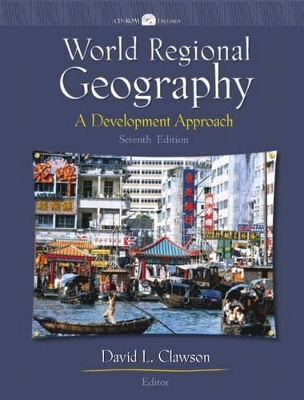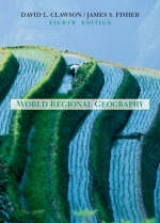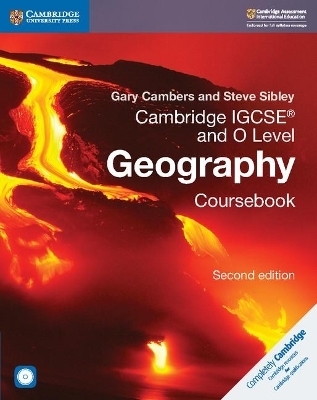
World Regional Geography
Pearson
978-0-13-055346-1 (ISBN)
- Titel erscheint in neuer Auflage
- Artikel merken
Organized around the central theme of human development, this text is authoritatively written by experts on each region of the world. Each author employs this human development theme to create a substantive volume on world regional geography that presents a vital, issue-oriented overview of the topic. This approach enables professors to engender a deeper understanding of the character of the world's people than the more traditional descriptive approach.
(NOTE: Each chapter concludes with Key Terms and Geography in Action. Several chapters also include Further Readings.)I. BASIC CONCEPTS AND IDEAS.
1. Geography: Many Worlds to Explore.
The Evolution of Geography. The Subdivisions of Geography. Geography and Other Disciplines. Careers in Geography. Geography and Development. Two Worlds. Summary: Patterns and Interactions.
2. People and Resources.
People. The Resource Concept. Summary: Population Prospects.
3. Physical and Cultural Components of the Human Environment.
Elements of the Physical Environment. Humanity and Culture. Social and Political Organization. Economic Activity. Economic Organization and Modernization. Summary: A Complex but Critical Relationship.
4. More Developed and Less Developed Countries: An Overview.
The Widening Gap. Measurements of Wealth. Characteristics of More Developed and Less Developed Regions. Theories of Development. Rostow's Stages. Summary: An Unequal World.
II. UNITED STATES AND CANADA.
5. The United States and Canada: The Bases for Development.
Physical Geography. Resources for Industrial Growth and Development. Early Settlement: European Culture Cores. Westward Expansion and Receding Settlement Frontiers. Demographic Characteristics. Summary: Resources for Anglo-American Development.
6. The United States and Canada: Economic Growth and Transformation.
Agriculture. Manufacturing in the United States and Canada. Industrialization and Urbanization. Summary: Continued Growth and Transformation.
7. The United States and Canada: Problems in a Developed Realm.
Income Disparity and Regional Problems. African Americans. Hispanic Americans. Other Minorities. Canadian Identity and Unity. “Melting Pot,” “Stew Pot,” or What? Summary: Canada and the United States in Retrospect.
III. EUROPE.
8. The European Habitat.
Landforms. Climate Regions. Hydrogeography. Mineral Resources. Environmental Modifications. Environmental Crises. Summary.
9. Europe: Culture, Society, Economy.
Religious Regions. Language Patters. Population. Level of Living. Immigration. Europe's Cities. Primary and Secondary Industries. Industrial Rejuvenation. Service Industries. Agriculture. Summary
10. Europe: Political Geography.
Separatism. Germany. France. Switzerland and Belgium. Yugoslavia: A Balkan Tragedy. The United Kingdom. Italy. Spain. The European Union. Summary
IV. RUSSIA AND THE EURASIAN STATES OF THE FORMER SOVIET UNION.
11.Russia and the Eurasian States of the Former Soviet Union: Land and People.
Natural Regions. Landform Regions. Population. Summary: A Vast Expanse.
12. Russia and the Eurasian States of the Former Soviet Union: Economic Activity.
The Soviet Approach. Planned Development. Soviet Economic Reforms. The Challenge of Development for the New Eurasian States. Economic Development Potential. Industrial Resources. Industrial Regions. Agriculture. Summary: An Unknown Future.
V. AUSTRALIA, NEW ZEALAND, AND THE PACIFIC ISLANDS.
13. Australian, New Zealand, and the Pacific Islands: Isolation and Space.
Australia. New Zealand. The Pacific Islands. Summary.
VI. ASIA, EAST BY SOUTH.
14. Asia, East by South: A Physical and Human Overview.
The Monsoon Climate: Wet and Dry Seasons. Population and Favored Environments. Unity and Diversity: Past and Present. Colonial and Modern Economics. Development Indicators. Summary: A Glimpse of the Developing World.
15. Japan: An Economic Giant.
Resources: Compensating for Scarcity. Human Resources: The Hybrid Culture. Japan's Modern Era (1868 to the Present). Japan's First Transformation: Rise to Power. Japan's Second Transformation: Rising from the Ashes of War. The Consequences of “Japan, Inc.” Japan's Third Transformation: Charting a New Course? Summary.
16. China and Its Pacific Rim Neighbors.
Environmental Diversity. Spatial Evolution of Chinese Culture. East Meets West. Transformation Under Communism. Transformation of Agricultural Production. Industry and Regional Economic Growth. Urbanization and Migration. Population Contours. Environmental Sustainability. Challenges to China's Future. China's Pacific Rim Neighbors. Summary: Forging a New Development Era.
17. Southeast Asia: Unity in Diversity.
Areal Organization and Environmental Patterns. Pre-European Culture and Economy. Colonialism and Development. Modern Economic Growth and Stagnation. Summary: Economic Transformation.
18. South Asia: The Past in the Present.
Environmental Contrasts. The Precolonial Heritage. Colonial Transformation. Independence and Nation-State Building. Population Contours of India. Agricultural Development in India. India's Industrial Economy. Urban India. Pakistan. Afghanistan. Nepal. Bangladesh. Sri Lanka. Summary: Development Prospects.
VII. THE MIDDLE EAST AND NORTH AFRICA.
19. The Middle East and North Africa: Physical and Cultural Environments.
Physical Geography of the Region. Land-Use Patterns. Historical Overview. Summary: A Region of Subtle Diversity.
20. The Mediterranean Crescent.
Large States, Integrated Economies. Small States, Unique Economies. Summary: Conflict in the Crescent.
21. The Gulf States.
Regional Characteristics. Development and the Petroleum Economy. The Impact of Oil. Petroleum Powerhouses: Isolation and Globalization. Summary: Oil, Development, and Traditional Values.
AFRICA SOUTH OF THE SAHARA.
22. Africa South of the Sahara: Legacy of Continuity and Change.
Environmental Diversity. Precolonial Africa. European Colonialism. Contemporary Sub-Saharan Africa. Development Trends in Sub-Saharan Africa. Summary.
23. West, Central, and East Africa: Diversity in Development.
The Physical Environment. West Africa. Central Africa. East Africa. Summary: Diversity in Regional Development.
24. Southern Africa: Development in Transition.
Physical-Environmental Characteristics of the Region. Countries of Southern Africa. South Africa: Country in Transition. Summary: Socioeconomic and Political Transformations.
IX. LATIN AMERICA.
25. Latin America: Physical Diversity and Cultural Heritage.
Physical Diversity. Iberian Heritage. The Colonial Period. The Era of Independence. Modern Latin America. Summary: A Region in Need of Change.
26. Mexico, Central America, and the Caribbean: Lands of Contrasts.
Mexico: A Nation in Search of Stability. Central America: Region of Fragile Democracies and Widespread Poverty. The Caribbean: Region of Cultural Diversity and Limited Physical Endowments. Summary: The Struggle for National Identity.
27. South America: Regions of Uneven Development.
Andean South America: Lands of Physical and Social Fragmentation. Southern South America: Lands of Economic Growth. Brazil: Latin America's Potential Economic Giant. Summary.
Appendix A: Map Scale and Projections.
Appendix B: Selected National Statistics.
Appendix C: Conversion Factors.
Glossary.
Credits.
Index.
| Erscheint lt. Verlag | 12.1.2001 |
|---|---|
| Sprache | englisch |
| Gewicht | 1623 g |
| Themenwelt | Naturwissenschaften ► Geowissenschaften ► Geografie / Kartografie |
| ISBN-10 | 0-13-055346-8 / 0130553468 |
| ISBN-13 | 978-0-13-055346-1 / 9780130553461 |
| Zustand | Neuware |
| Informationen gemäß Produktsicherheitsverordnung (GPSR) | |
| Haben Sie eine Frage zum Produkt? |
aus dem Bereich


